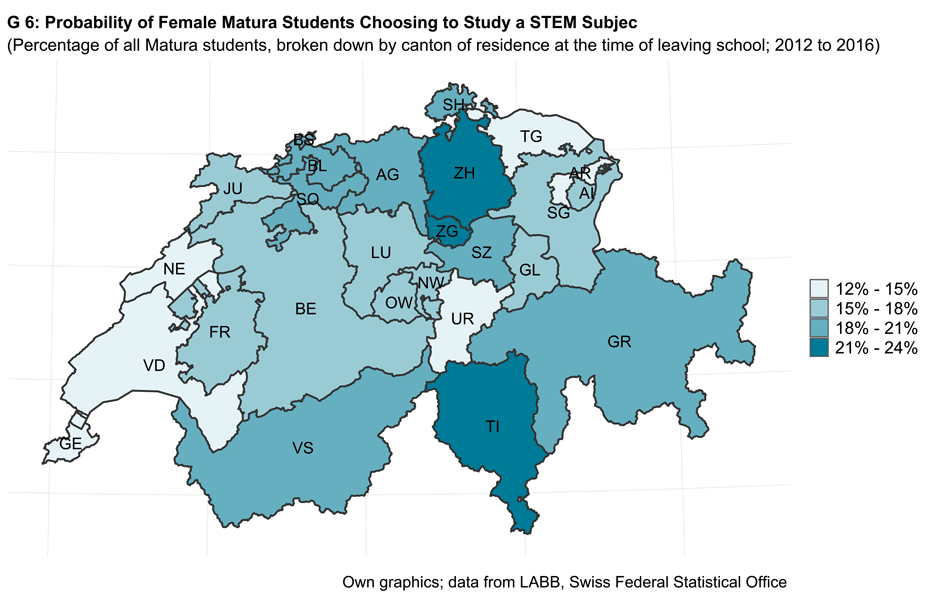Proportion of women in STEM subjects: major differences between cantons
- Labour Market
- KOF Bulletin
In Switzerland the proportion of women studying technical subjects is lower than in most other OECD countries. Despite many support programmes, this situation has hardly changed in the last ten years. A study based on new educational data reveals major cantonal differences: in the cantons of Zurich and Zug, for example, twice as many female Matura students embark on STEM courses as in Geneva and Uri.

The demand for workers with expertise in science, technology, engineering and maths (STEM) subjects remains high. Nevertheless, few women choose to study STEM. Switzerland, for example, has one of the lowest proportions of female STEM graduates in the OECD at 22 per cent (2017) (see G 4). Among its neighbouring countries, Germany and Austria have proportions of 26 per cent and 28 per cent respectively, while the relevant share in France and Italy is 32 per cent and 40 per cent respectively.

The gender ratio in the STEM sector is not only important for Swiss companies looking for qualified workers. It also has a direct impact on pay differentials in the labour market. For example, higher wages are paid in STEM professions than in less technical occupations. If women are underrepresented in the STEM sector compared with men, they therefore earn less. The choice of subjects to study has a causal effect on future income. According to Goldin, Katz and Kuziemko (2006), a good third of the pay gap between men and women can be attributed to different educational choices.

Charitable foundations, educational institutions and companies have launched numerous STEM funding programmes in Switzerland in recent years. Nevertheless, the gender ratio has hardly changed in the last ten years. Between 2009 and 2019 the probability of women embarking on a STEM course of study rose from 17.3 per cent to only 20.6 per cent, while for men it climbed from 43.9 per cent to 48.4 per cent. The proportion of women in computer science and on technical programmes is still particularly low (see G 5).
Effective support measures are difficult
Why is the proportion of women on STEM degree programmes increasing only slowly? Female students are now no longer explicitly discouraged from studying STEM subjects. However, international research shows that implicit values and norms have a great influence. Carlana (2019), for example, shows that unconscious bias among teachers can cause female pupils to perform worse in mathematics at school and can contribute to their decision not to specialise in maths at secondary school. Classmates, parents and siblings or the institutional school environment can also propagate implicit stereotypes and help to reduce female pupils’ interest in mathematical subjects, e.g. in the case of the ‘mathematics in the classroom’ project (Brenoe and Zoelitz 2019; Mouganie and Wang 2020; Dahl, Rooth and Stenberg 2020; Joensen and Nielsen 2016).
This makes it very difficult to mitigate the differences. Moreover, interventions can also have unintended consequences. This is shown, for example, by a STEM support initiative in France, where female engineers visited secondary schools and gave an insight into their work (Breda, Grenet and Monnet 2020). This measure initially caused female pupils to expect to be discriminated against in technical professions.
Cantonal differences seen as an opportunity
With new data available from the Swiss Federal Statistical Office it is now possible for the first time in Switzerland to analyse more precisely where gender differences occur before students even start university. For example, chart 6 shows the probability of female Matura students embarking on a STEM degree programme, broken down by canton of residence at the time of leaving school.

While technical courses of study are more popular with men than with women in all cantons, there are major differences between cantons. In the cantons of Zurich, Ticino and Zug, around 24 per cent of female Matura students embark on a STEM degree course, whereas in the cantons of Geneva, Uri and Appenzell Innerrhoden this figure is only just over 12 per cent. The relevant proportion is similarly low in the cantons of Thurgau and Neuchâtel.
There are currently no scientific studies on the causes of these cantonal differences. International research suggests that, among other factors, the school environment is likely to be a contributing factor – especially in Switzerland, where the education system is organised on a cantonal basis and the cantons have a great deal of leeway in designing it. A better understanding of the causes of these cantonal differences might allow the more targeted encouragement of women in the STEM sector.
A detailed version of this article will appear in the next KOF analyses at the end of October.
Contact
KOF FB Konjunktur
Leonhardstrasse 21
8092
Zürich
Switzerland